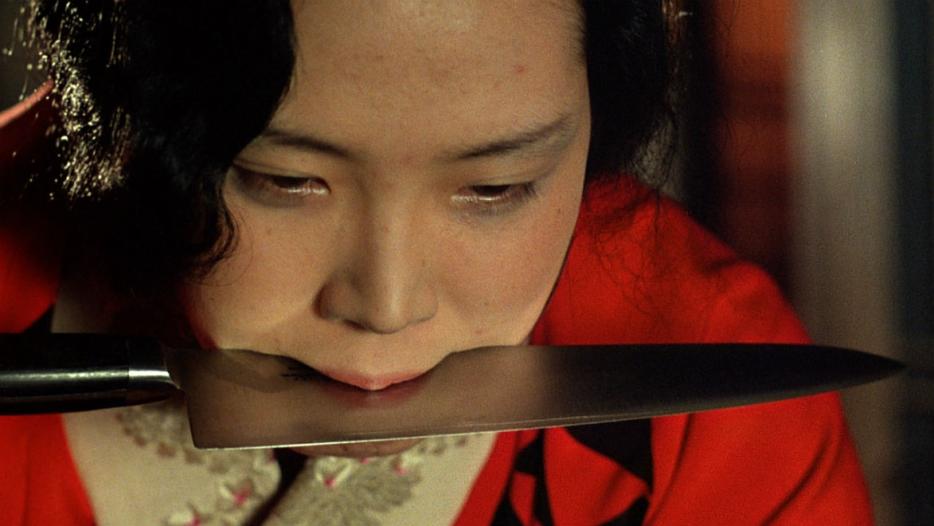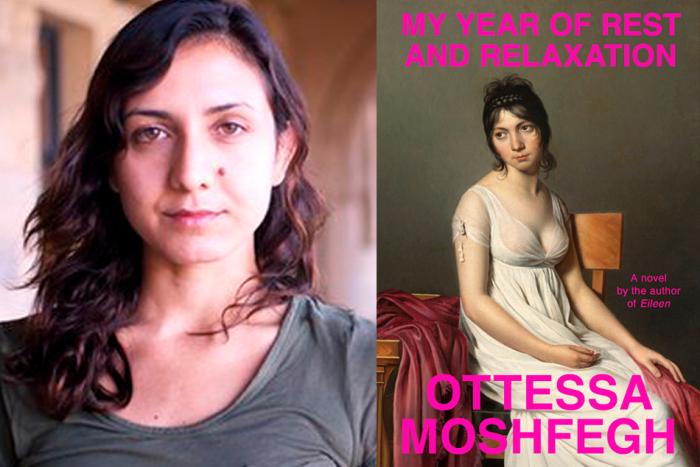A recording for Belgian television in 1976 is perhaps the only extant on-camera interview with Matsuda Eiko. The actress appears flanked by costar Fuji Tatsuya and Ōshima Nagisa, the director of the movie the two actors are promoting. Conscious of the firestorm already brewing around their film (which was swiftly banned in Belgium, neither the first nor the last time it would face censorial scrutiny), Ōshima fields most of the questions with an impresario’s disarming eloquence and easy charm. Fuji, for his part, is quiet throughout, and when the interviewers at last—briefly—turn to Matsuda, her answers lack the camera-ready polish one might expect of a trained performer. Halting but unmistakably genuine in her speech, she seems to be drawing the words up from the well of her soul. “I cannot describe how tough it was,” she says, asked about her experience mentally preparing herself for the role. But: “I felt it was my destiny to be in this film.”
The film in question was In the Realm of the Senses, which would variously be described as intolerable, genius, criminally obscene, and one of the most iconic works in Japanese cinematic history. Despite the extreme legal and critical backlash that greeted its release, In the Realm of the Senses would ultimately be a career-making move for two of the three people sitting on the interview panel that day. At the time of his death in 2013, newspaper obituaries would almost unanimously cite it as Ōshima’s most important work, while Fuji, the lead actor, would go on to secure numerous major movie roles on the strength of his performance in the film, leaving behind his roots as a mid-tier TV actor. But if the years that followed the premier of In the Realm of the Senses marked a period of ascendancy for her male colleagues, the same timespan would see Matsuda leaving Japan, leaving the cinema, and disappearing from public view. Not every destiny is a happy one.
*
In the Realm of the Senses was controversial by design. Based on the true story of the murderess-turned-national-icon Abe Sada, a former sex worker whose brief but intense romance with Ishida Kichizō ended with his death and castration at her hands, the film was conceived in part to take advantage of recently loosened obscenity laws in France, news of which prompted French producer Anatole Dauman to joke (or half-joke) that he and Ōshima should “make a porn flick.”
For his cinematic translation of Abe’s story, perhaps the greatest articulation of obsession in the scope of cinema, Ōshima decided that the only way to capture the magnitude of the central couple’s single-minded passion while avoiding tawdry sappiness was to depict it using unsimulated sexual intercourse. Shipping the footage to Paris for development prevented the project from folding under obscenity charges before it even reached theaters; to this day, however, the only uncensored screening of In the Realm of the Senses in Japan ever documented took place when the edited film was shown for a room of presumably shocked customs agents on its way back into the country.
Yet while its origin story might make it tempting to write the film off as little more than scandal bait, In the Realm of the Senses is of a piece with Ōshima’s broader œuvre, which provokes in ways that are deeply philosophically engaged. Death by Hanging (1968) is a sharp and formally daring indictment of state violence and anti-Korean racial prejudice; Night and Fog in Japan (1960) chronicles the fractures and failings of the Japanese Left with which Ōshima nevertheless aligned himself. With In the Realm of the Senses, then, the director sought to challenge Japan’s conservative political mores by pushing its aesthetic ones. And the film, which contains extended, unflinchingly shot sequences of graphic nudity and sexual content in virtually every scene, pushes about as far as it is possible to go.
All of this, of course, would not have been possible without actors willing to put their bodies and their reputations on the line in the service of such a statement. Fuji, who up until his casting had mostly worked in television and exploitation films, was by all accounts far from the director’s first choice for the role of Ishida, but the difficulty of casting actors willing to be filmed having sex narrowed Ōshima’s available choices considerably.
Matsuda, on the other hand, had different training: she had gotten her start with Terayama Shūji’s theater troupe Tenjō Sajiki, which had positioned itself as the vanguard of the Japanese underground by mashing together such diverse influences as traditional folklore, jazz, and the short stories of Jorge Luis Borges. Tenjō Sajiki also frequently courted scandal due to the frank eroticism of its productions. Though at the beginning of her career—Matsuda was in her mid-twenties when work on In the Realm of the Senses began, a decade younger than her costar—her prior experience had given her an understanding of avant-garde, politically daring artmaking that set her apart. In interviews for the Criterion Collection, cast and crew members pointed to one thing in particular that crystallized Matsuda’s perspective for them: a tiny scorpion tattoo curled in the teardrop space of her earlobe (an early scene from In the Realm of the Senses calls attention to it). In a country where tattoos are so strongly associated with criminality that to this day it’s not uncommon for hot springs and beaches to require visitors who have them to cover up, Matsuda’s diminutive scorpion was a bold statement, a testament to her willingness to embody rebellion against the status quo.
The filming process was a difficult one: due to the legal risk of obscenity charges, the project had to be kept under tight wraps to prevent the authorities from catching wind of it. Though stress was no doubt high, those involved in the project recall Ōshima’s politeness and calm demeanor, the opposite of the familiar archetype of the overbearing director. Still, despite Ōshima’s sensitivity to the emotional challenge presented by the principal roles—making sure, for instance, that when sex scenes were filmed the set was vacated to grant as much privacy as possible—the extreme physical demands could not be sidestepped. In one the most bizarre sequences in the movie, Ishida inserts a boiled egg into his lover’s vagina. During the first attempt to shoot the scene, an undercooked egg broke after insertion. “Actresses who can take on a project like In the Realm of the Senses just don’t exist in Japan—actresses with that resolve and with that faith in film, that faith in cinema and respect for cinema as an art form,” Fuji later recalled. “Without those things and without courage, you can’t take it on.”
*
The difficulties that confronted In the Realm of the Senses and the artists involved in making it did not stop when the shooting process was over. In country after country, censorship orders were handed down: customs officials barred it from appearing in the New York Film Festival; Japan, unable to prosecute Ōshima for the film itself due to the fact that it was technically a French production, instead brought charges against him after a book containing stills and script excerpts was published, alleging that they “needlessly arouse[d] sexual desires and violate[d] good sexual morality.” Though Ōshima was eventually acquitted, the trial dragged on for years. Critics were often similarly eager to condemn: a review in The New York Times was given the tart title “‘In the Realm of the Senses is rated ‘W,’ for ‘Why?’” and said of the final castration scene: “The movie was dying anyway; now, after pretty well stupefying, it wounds.” While In the Realm of the Senses had its fair share of early advocates, many simply dismissed the film as prettily shot pornography.
Yet key to understanding the cinematic importance of In the Realm of the Senses, and the ways in which it resists this one-dimensional appraisal, is a recognition of the film’s political elements. Compared to many of Ōshima’s other major works, the elements of political critique in In the Realm of the Senses are subtextual, perhaps disappointingly so—but they are present nevertheless. Easily missed is the fact that Ōshima deliberately aligns Abe and Ishida’s affair with the February 26th Incident, which resulted in the Japanese military’s consolidation of power over civilian government. In one scene, Ishida, en route to a romantic assignation with Abe, nonchalantly passes a seemingly endless line of soldiers; when Ōshima told Fuji during filming that he was considering cutting the scene, the actor replied that in that case he would walk. The scene stayed, and was cited by many involved with In the Realm of the Senses as one of the parts of the film they found most meaningful. Set against the fever-pitch nationalism of the 1930s—during which sacrifice to the point of suicide was valorized by a totalitarian government that also preached massive territorial expansion and racial supremacism—Abe and Ishida’s absolute (and ultimately fatal) focus on the pleasures of the flesh constitutes a repudiation of the state’s collectivist ideology. In other words, to write off the film as devoid of anything but sexual content is to miss the artistic statement that the cast and crew felt lay at the heart of their work. An early shot in which a child pokes at a beggar’s exposed genitals with a toy Japanese flag succinctly captures this idea in a single image: given the social milieu of both the film’s setting and the time it was made, a radical sexual statement is a radical political statement, even an anti-imperialist one.
Yet this aspect of social critique was largely lost on viewers more hung up on the film’s use of unsimulated sex which, despite Ōshima’s argument that openness negated obscenity, continued to scandalize. The weight of this outrage, as it happened, fell disproportionately on Matsuda. Even resoundingly negative reviews praised the actress for her commitment and emotional intensity, but public perception of her in Japan was of someone morally compromised, dirtied by her involvement, and unfit for serious film work. While Fuji went on to land the lead role in Ōshima’s Palme d’Or-winning Empire of Passion (1978)—in many ways a spiritual successor to In the Realm of the Senses—his former co-star got offers for nude dancing contracts and porn films. Her once-ascendant star now seemed permanently to dim, and then to fall: dogged by press censure in her home country, Matsuda appeared in a handful of seedy “pink movies” before moving to Europe, where, after making a final appearance in the minor French film Five and the Skin (1982), she left acting entirely.
*
Perhaps as remarkable as Matsuda’s performance and her sudden withdrawal from her craft is the fact that her story has gone largely unexplored by critics despite the global prominence of her best-known work. Both lay and scholarly writings on In the Realm of the Senses tend to confine themselves to her work in the film and give almost no consideration to what, for her, came after.
The only real exception to this is the historian of Japanese film Donald Richie, who tracked down and interviewed Matsuda for an essay published in his 1987 book Different People. Richie rightly underscores the fact that Matsuda’s treatment in the press (and the subsequent drying-up of her career) differed sharply from the reception that greeted her male colleagues but, elsewhere in the piece, he replicates the very attitudes he criticizes. Describing Matsuda’s tasteful dress and cultivated demeanor during their conversation, Richie notes in a leering aside that this was “the same woman I remembered as all muscles, juice, and open thighs.” Elsewhere: “Her naked flesh was more real to me than the poised elegance now sitting beside me on a Roman balcony.” The language here unapologetically sexualizes Matsuda despite occurring in the context of an essay that upbraids the Japanese film industry for failing to see her as anything more than a porn star; it is as though by agreeing to perform in the film Matsuda had signed up for the status of Permanent Sex Object. Richie is not the only one to regard Matsuda this way: at one point during the Belgian TV interview, the camera zooms in abruptly and lingers without explanation on Matsuda’s breasts.
Richie’s essay also construes Matsuda’s offscreen manner as a “sexless chic” in which she is “immured,” an inauthentic cover, he feels, for the true self she was allowed to express while playing Abe. Indeed, is it hard to reconcile the mousy, timid Matsuda of the Belgian TV panel with the bold uninhibitedness and confident physicality of her character? Well, only if one has difficulty imagining that an artist may have the power to invent. Here Richie makes the same mistake as Matsuda’s critics in Japan: an inability to distinguish between the artist and the art, a rhetorical projection of performance onto performer to the detriment, ultimately, of both. By conflating Matsuda’s personality with that of her character, Richie implicitly denies the actress artistry, interpreting her performance as a simple release of emotional energy rather than the intellectual product of a considered aesthetic and political position.
Yet this kind of slippage persistently characterizes writing around women’s art practices to this day, a prurient interest in stripmining pieces for juicy “autobiographical” content to the exclusion of considering them as works of standalone creation. Among the many stories spun out of Kristen Roupenian’s viral New Yorker piece “Cat Person” was the phenomenon of just how many readers mistook the work of fiction for an essay. A still more recent example can be found in the critical response to Motherhood, Sheila Heti’s latest novel (and here I feel a certain temptation to underline that last word): as Lauren Oyler notes in her piece for The Baffler, “Of all her autofictional cohort Heti has dealt the most with the conflation of her narrator with herself, and along with this critical mistake come accusations of narcissism.” Oyler takes Alexandra Schwartz in particular to task for the latter’s “obtuse” review of the book for The New Yorker, in which the author’s open skepticism of Motherhood’s inclusion in the category of “novel” allows literary criticism to slide into cutting assessments of personal character, such as that Heti herself is “petulant” and “bratty.” It is worth asking, in 2018, how far we have come and how far we still have to go.
*
Though the international fame of In the Realm of the Senses—now widely regarded as one of the most important films of the Japanese New Wave—has engendered a flurry of reviews, articles, and interviews in the decades since its scandalous premier, there is a dearth of both media and scholarly attention towards Matsuda, any interest in charting her life or hearing her experience. Matsuda’s death from a brain tumor in 2011 went unnoticed by the press; by contrast, a flood of obituaries from around the world greeted the news of Ōshima’s passing just two years later, many of which prominently featured iconic stills of Matsuda as Abe. In the minds of arthouse theatergoers, her unforgettable performance in In the Realm of the Senses had become an instantly recognizable metonym for the height of Ōshima’s directing powers but left no room for a consideration of the performer herself. The question that forms the silent heart of this essay is therefore precisely this: how to rewrite into history someone so thoroughly written out, how to recover the voice of someone whose words almost nobody thought to record, someone who for so many was simply an empty vessel for their own desire.
The real-life Abe Sada rose to the unlikely status of folk icon after news of her crime became a media sensation: despite personally requesting the death penalty at her trial, sympathy for her cause was so great that she was sentenced to only six years (of which she served five). For decades after Ishida’s murder, the story of two lovers consumed not by jealousy but by the too-intense flame of their passion captured the imagination of artists as well as the general populace. It is a cruel irony that the same public who were willing to look past the lurid and the gruesome and accept Abe’s story as one of love proved categorically unwilling to extend a similar generosity of heart towards the woman who played her onscreen. If Abe and her lover were applauded for their ultimately doomed pursuit of individualism at the height of Japan’s nationalistic fervor, Matsuda’s own anti-establishment political statement brought an end to her young career. It is a risk that Matsuda must have considered when she committed to the project, and it is a testament to her powers as an actor that none of this fear for what may come leeches into her performance. If there is something that unites her and Abe after all, then perhaps it is this: the understanding that when the future holds only ruin one may as well stand and let the full fire of the present moment flow.






